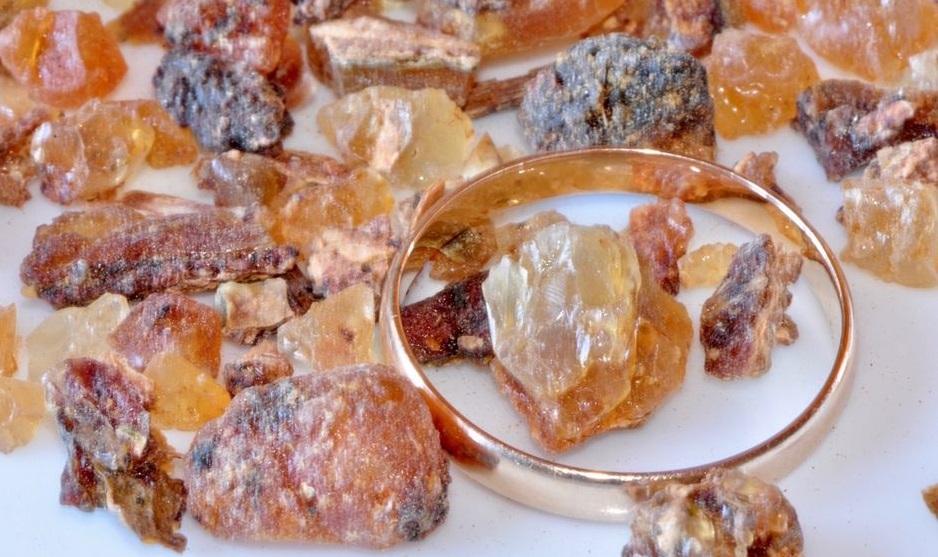Myrrh is a resinous, aromatic substance which is obtained from the trunk of a bush or small tree known scientifically as Commiphora myrrha. It is native to Northeast Africa, Arabia and Turkey.
 Small crystals of myrrh. / Photo: Antonio Cruz
Small crystals of myrrh. / Photo: Antonio Cruz
On coming to the house, they saw the child with his mother Mary,
and they bowed down and worshiped him.
Then they opened their treasures and presented him
with gifts of gold, frankincense and myrrh. (Mt. 2:11)
Myrrh is a resinous, aromatic substance which is obtained from the trunk of a bush or small tree known scientifically as Commiphora myrrha. It is native to Northeast Africa, Arabia and Turkey.
In ancient times it was a highly valued substance as it was used to make expensive perfumes, incense and oils, such as that used for holy anointing (Ex. 30:31; Psalm 45:8; Proverbs 7:17; Song of songs 1:13; 5:5); ointments for the purification of women (Esther 2:12); and a means of perfuming beds and clothing (Song of Songs 3:16); wine was mixed with myrrh to obtain an anaesthetic medicine (Mark 15:23); and it was also used to embalm corpses (John 19:39), and also to thin ink on parchments.
Myrrh was one of the substances brought to Egypt by the Ishmaelite merchants (Genesis 37:25), considered as it was to be among the best products of the land (Genesis 43:11). It was also one of the gifts given to the baby Jesus by the Magi (Mat. 2:11). Its Hebrew name is mor, and etymologically it comes from a root word meaning “bitter”. In Arabic it is morr, while in Greek it is smyrna, from which the city Smyrna derives its name on the Aegean coast; and in Latin its name is myrrha.
Both the myrrh Bush and the incense tree (Boswellia carteri), which grow in desert and sub-Saharan regions, have always played, and still play, an important role in many religions. Both spices produce resins which used to be burnt so that their volatile oils would perfume the air. It is possible that, initially, this was done at funerals with the aim of mitigating the bad smells from the corpses, and that they gradually came to form part of other religious rituals.
As incense and myrrh have always been so closely related, some naturalists from ancient times confused the vegetal species in which they originated. Although both species belong to the same family of Burseraceae, they are entirely different from each other, as can be appreciated in the drawings that appear in the first volume of the book Medicinal Plants, by R. Bentley and H. Trimen, published in 1880.
The leaves of the myrrh tree are green, with two small lateral leaflets. The fruit is small and dark, while the colour of the resin varies from pale yellow to reddish brown. Its taste is bitter, and it has astringent properties which are used as an antiseptic and stimulant.
Right up to the present day, the myrrh resin is obtained by making an incision on the bark of the tree. After that, they wait until sticky drops appear which, as they dry, turn red and shiny. The myrrh that is obtained in this way is also used as a substitute for incense.
The quote at the top of this article refers to the gifts that the Magi offered the newborn baby Jesus: gold, incense and myrrh. These three gifts were all considered extremely expensive luxury articles, which were imported. Even in the first years of Christianity, some of the Church fathers, including Irenaeus and Origen, saw in myrrh a reference to Christ’s death (Mark 15:23; John 19:39). Nevertheless, that child who was worshipped by Pagans and rejected by his own people, died on a Roman cross, only to rise again on the third day and thus offer hope to humankind.

Las opiniones vertidas por nuestros colaboradores se realizan a nivel personal, pudiendo coincidir o no con la postura de la dirección de Protestante Digital.
Si quieres comentar o